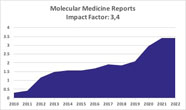| View this email on your browser |
Roles of endoplasmic reticulum stress and autophagy on H2O2‑induced oxidative stress injury in HepG2 cells Zhiming Wu, Huangen Wang, Sunyang Fang, Chaoyang Xu View Abstract ❯ | 
  |
Anti‑breast cancer activity of selected 1,3,5‑triazines via modulation of EGFR‑TK Weixin Yan, Yiyang Zhao, Jianrong He View Abstract ❯ |
Bioinformatics analyses of significant genes, related pathways and candidate prognostic biomarkers in glioblastoma Lingqi Zhou, Hai Tang, Fang Wang, Lizhi Chen, Shanshan Ou, Tong Wu, Jie Xu, Kaihua Guo View Abstract ❯ |
Network analysis of membranous glomerulonephritis based on metabolomics data Amir Taherkhani, Shiva Kalantari, Afsaneh Arefi Oskouie, Mohsen Nafar, Mohammad Taghizadeh, Koorosh Tabar View Abstract ❯ |
|
|
|
|
|
|
|
|
|
|
|
|
|
|
|
|
|
|
|
|
|
|
|
|
|
|
|
|
|
|
|
|
|
|
|
|
|
|
|
|
|
|
|
|
|
|
|
|
|
|
|
|
|
|
|
|
|
|
|
|
|
|
|
|
|
|
|
|
|
|
|
Effect of chemokine CC ligand 2 (CCL2) on α‑synuclein‑induced microglia proliferation and neuronal apoptosis Lijun Zhang, Pengju Ma, Qingkai Guan, Lei Meng, Linlin Su, Lina Wang, Bin Yuan View Abstract ❯ |
Protective effects of α‑2‑macroglobulin on human bone marrow mesenchymal stem cells in radiation injury Yang Liu, Wanting Cao, Xiangbo Kong, Jie Li, Xueying Chen, Yaping Ge, Wanzhen Zhong, Silian Fang View Abstract ❯ |
Comprehensive analysis of multi Ewing sarcoma microarray datasets identifies several prognosis biomarkers Xuqing Yin, Jiubo Sun, Haiyang Zhang, Shuai Wang View Abstract ❯ |
Long non‑coding RNA ferritin heavy polypeptide 1 pseudogene 3 controls glioma cell proliferation and apoptosis via regulation of the microRNA‑224‑5p/tumor protein D52 axis Yongqiang Zhang, Ying Li, Jing Wang, Ping Lei View Abstract ❯ |
Distribution and prognostic value of tumor‑infiltrating T cells in breast cancer Shaoda Meng, Li Li, Meiling Zhou, Wanjie Jiang, Heng Niu, Kunxian Yang View Abstract ❯ |
BACE1 gene silencing alleviates isoflurane anesthesia‑induced postoperative cognitive dysfunction in immature rats by activating the PI3K/Akt signaling pathway Ying‑Bin Wang, Jian‑Qin Xie, Wei Liu, Rong‑Zhi Zhang, Sheng‑Hui Huang, Yan‑Hong Xing View Abstract ❯ |
Genetic mutation of familial dilated cardiomyopathy based on next‑generation semiconductor sequencing Xin‑Fu Lin, Jie‑Wei Luo, Gui Liu, Yao‑Bin Zhu, Zhao Jin, Xing Lin View Abstract ❯ |
Combination of pristimerin and paclitaxel additively induces autophagy in human breast cancer cells via ERK1/2 regulation Younju Lee, Jinuk Na, Myung Sun Lee, Eun Young Cha, Ji Young Sul, Jun Beom Park, Jin Sun Lee View Abstract ❯ |
Pharmacological basis for application of scutellarin in Alzheimer's disease: Antioxidation and antiapoptosis Xinyu Hu, Shanshan Teng, Jiawei He, Xiaoqi Sun, Mingzhao Du, Ling Kou, Xiaofeng Wang View Abstract ❯ |
Elevated methylation of OPRM1 and OPRL1 genes in Alzheimer's disease Chunshuang Xu, Guili Liu, Huihui Ji, Weihua Chen, Dongjun Dai, Zhongming Chen, Dongsheng Zhou, Lei Xu, Haochang Hu, Wei Cui, Lan Chang, Qin Zha, Liping Li, Shiwei Duan, Qinwen Wang View Abstract ❯ |
Effect of emodin on T cell subsets in NOD mice with NaI‑induced experimental autoimmune thyroiditis Huaqin Sun, Zhipeng Ye, Ning Li, Fa Jin, Jiuliang Yan, Keren Wu View Abstract ❯ |
Modular bioinformatics analysis demonstrates that a Toll‑like receptor signaling pathway is involved in the regulation of macrophage polarization Biao Ma, Yang Yang, Zhituo Li, Dali Zhao, Weihui Zhang, Yanfeng Jiang, Dongbo Xue View Abstract ❯ |
Cytoprotective effects of the medicinal herb Astragalus membranaceus on lipopolysaccharide‑exposed cells Xian Wu, Wei Zhou, Qingshuang Wei, Peng Chen, Yan Li View Abstract ❯ |
Protein phosphatase 2A regulates the p38 signaling pathway to affect the migration of astrocytes Lijun Zhang, Pengju Ma, Qingkai Guan, Lei Meng, Linlin Su, Lina Wang, Jianhua Zhao, Sibei Ji View Abstract ❯ |
Deletion of poly(ADP‑ribose) polymerase-1 changes the composition of the microbiome in the gut András Vida, Gábor Kardos, Tünde Kovács, Balázs L. Bodrogi, Péter Bai View Abstract ❯ |
Amino acid starvation promotes podocyte autophagy through mammalian target of rapamycin inhibition and transcription factor EB activation Yuanhan Chen, Xingchen Zhao, Jiaxin Li, Li Zhang, Ruizhao Li, Hong Zhang, Ruyi Liao, Shuangxin Liu, Wei Shi, Xinling Liang View Abstract ❯ |
Angiotensin II upregulates cyclophilin A by enhancing ROS production in rat cardiomyocytes Hangyu Tian, Dan Yu, Yan Hu, Pan Zhang, Yang Yang, Qiang Hu, Ming Li View Abstract ❯ |
Downregulation of FOXK2 is associated with poor prognosis in patients with gastric cancer Xi Liu, Xiaodong Wei, Wei Niu, Dong Wang, Bo Wang, Hao Zhuang View Abstract ❯ |
Molecular pathogenesis involved in human idiopathic pulmonary fibrosis based on an integrated microRNA‑mRNA interaction network Lijing Wang, Wei Huang, Lemeng Zhang, Qiong Chen, Hongjun Zhao View Abstract ❯ |
CXCL12 induces migration of oligodendrocyte precursor cells through the CXCR4‑activated MEK/ERK and PI3K/AKT pathways Yongyang Tian, Hong Yin, Xi Deng, Beichuan Tang, Xianjun Ren, Tao Jiang View Abstract ❯ |
Dicer affects cisplatin‑mediated apoptosis in epithelial ovarian cancer cells Xi Wang, Hui Chen, Yiping Wen, Xiaoxin Yang, Qing Han, Ping Jiang, Zaiju Huang, Jing Cai, Zehua Wang View Abstract ❯ |
Streptozotocin‑induced diabetic mice exhibit reduced experimental choroidal neovascularization but not corneal neovascularization Gaoqin Liu, Lei Chen, Qinhua Cai, Hongya Wu, Zhigang Chen, Xueguang Zhang, Peirong Lu View Abstract ❯ |
Regulation of the NLRP3 inflammasome and macrophage pyroptosis by the p38 MAPK signaling pathway in a mouse model of acute lung injury Dandan Li, Weiying Ren, Zhilong Jiang, Lei Zhu View Abstract ❯ |
Estrogen restricts the apoptosis of endometrial stromal cells by promoting TSLP secretion Hui‑Li Yang, Kai‑Kai Chang, Jie Mei, Wen‑Jie Zhou, Li‑Bing Liu, Li Yao, Yi Meng, Ming‑Yan Wang, Si‑Yao Ha, Zhen‑Zhen Lai, Jiang‑Feng Ye, Da‑Jin Li, Ming‑Qing Li View Abstract ❯ |
Comparing the role of Ginkgolide B and Ginkgolide K on cultured astrocytes exposed to oxygen‑glucose deprivation Wen‑Bo Yu, Liang Cao, Yan‑Yin Zhao, Wei Xiao, Bao‑Guo Xiao View Abstract ❯ |
FKBP11 protects intestinal epithelial cells against inflammation‑induced apoptosis via the JNK‑caspase pathway in Crohn's disease Xiaotong Wang, Xiaopeng Cui, Chuanwu Zhu, Ming Li, Juan Zhao, Zhongyi Shen, Xiaohang Shan, Liang Wang, Han Wu, Yanting Shen, You Ni, Dongmei Zhang, Guoxiong Zhou View Abstract ❯ |
Two Paired Box 6 mutations identified in Chinese patients with classic congenital aniridia and cataract Ying Lin, Hongbin Gao, Yi Zhu, Chuan Chen, Tao Li, Bingqian Liu, Cancan Lyu, Ying Huang, Haichun Li, Qingxiu Wu, Chenjin Jin, Xiaoling Liang, Xinhua Huang, Lin Lu View Abstract ❯ |
Using Illumina Infinium HumanMethylation 450K BeadChip to explore genome‑wide DNA methylation profiles in a human hepatocellular carcinoma cell line Ning Sun, Jialin Zhang, Chengshuo Zhang, Yue Shi, Bochao Zhao, Ao Jiao, Baomin Chen View Abstract ❯ |
Adoptive transfer of xenoantigen‑stimulated T cell receptor Vβ‑restricted human regulatory T cells prevents porcine islet xenograft rejection in humanized mice Xi Jin, Min Hu, Lina Gong, Huifang Li, Yan Wang, Ming Ji, Hong Li View Abstract ❯ |
Protective effect of berberine on aconite‑induced myocardial injury and the associated mechanisms Xueyan Chen, Huicai Guo, Qing Li, Yu Zhang, Huanlong Liu, Xiaofei Zhang, Kerang Xie, Zhongning Zhu, Qingfeng Miao, Suwen Su View Abstract ❯ |
Platelet‑rich fibrin exudate promotes the proliferation and osteogenic differentiation of human periodontal ligament cells in vitro Xiaoju Li, Huixiao Yang, Zijiian Zhang, Zhonghai Yan, Huling Lv, Yan Zhang, Bin Wu View Abstract ❯ |
Role of the Rho/ROCK signaling pathway in the protective effects of fasudil against acute lung injury in septic rats Yu Wang, Xiaofeng Wang, Wei Liu, Lichun Zhang View Abstract ❯ |
Identification of key genes and associated pathways in KIT/PDGFRA wild‑type gastrointestinal stromal tumors through bioinformatics analysis Wen‑Jie Wang, Hong‑Tao Li, Jian‑Ping Yu, Yu‑Min Li, Xiao‑Peng Han, Peng Chen, Wen‑Wen Yu, Wei‑Kai Chen, Zuo‑Yi Jiao, Hong‑Bin Liu View Abstract ❯ |
Protective effects of taurine against inflammation, apoptosis, and oxidative stress in brain injury Xiaoli Niu, Simin Zheng, Hongtao Liu, Siyuan Li View Abstract ❯ |
Complement depletion with cobra venom factor alleviates acute hepatic injury induced by ischemia‑reperfusion Bing Wang, Hua Xu, Jian Li, Hong‑Mei Gao, Ying‑Hong Xing, Zhu Lin, Hong‑Jie Li, Yong‑Qiang Wang, Shu‑Hua Cao View Abstract ❯ |
Aldehyde dehydrogenase activity in cryopreserved cord blood cells for quality assessment prior to transplantation Junko Ikemoto, Satoshi Yoshihara, Tamami Kobayashi, Shunro Kai, Yoshihiro Fujimori View Abstract ❯ |
Theanine, an antitumor promoter, induces apoptosis of tumor cells via the mitochondrial pathway Yinqiang Xin, Peiling Ben, Qi Wang, Yanyan Zhu, Zhimin Yin, Lan Luo View Abstract ❯ |
Expression and clinical significance of ubiquitin‑specific‑processing protease 34 in diffuse large B‑cell lymphoma Chunyao Li, Lanshan Huang, Huiping Lu, Wei Wang, Gang Chen, Yongyao Gu, Qianping Zhou, Zhigang Peng, Zhenbo Feng View Abstract ❯ |
Epigallocatechin‑3‑gallate protects against secondary osteoporosis in a mouse model via the Wnt/β‑catenin signaling pathway Jiancheng Xi, Qinggui Li, Xiaobo Luo, Jinlong Li, Lixin Guo, Haibin Xue, Guangsen Wu View Abstract ❯ |
miRNA‑328 overexpression confers cisplatin resistance in non‑small cell lung cancer via targeting of PTEN Chunmei Wang, Shijun Wang, Feng'e Ma, Weidan Zhang View Abstract ❯ |
Silencing of perilipin by short hairpin RNA inhibits proliferation and induces apoptosis in liposarcoma cells Ling‑Xin Meng, Yu‑Xiu Zheng, Mao‑Lei He, Xiao‑Ming Zhou, Shu‑Yan Sun, Zhao‑Jun Ding, Qin Meng, Bing‑Cheng Li, Yan‑Wei Sun View Abstract ❯ |
Protection of insulin‑like growth factor 1 on experimental peripheral neuropathy in diabetic mice Hua Wang, Hao Zhang, Fuming Cao, Jiaping Lu, Jin Tang, Huizhi Li, Yiyun Zhang, Bo Feng, Zhaosheng Tang View Abstract ❯ |
Bafilomycin A1 alleviates depression‑like symptoms in chronic unpredictable mild stress rats Zhijian Wang, Shengbing Liu, Weiwei Pan, Yanjun Guo, Zhongfei Shen View Abstract ❯ |
Huwe1 is a novel mediator of protection of neural progenitor L2.3 cells against oxygen‑glucose deprivation injury Xiaoqin Jiang, Jiyun Yang, Hedong Li, Yi Qu, Wenming Xu, Haiyan Yu, Yu Tong View Abstract ❯ |
Cantharidin inhibits melanoma cell proliferation via the miR‑21‑mediated PTEN pathway Zhen Mu, Qing Sun View Abstract ❯ |
Analysis of virulence diversity of 73 Helicobacter pylori strains isolated in Guizhou province, China Lin Yin, Fang Liu, Changcheng Guo, Qiong Wang, Ke Pan, Liangbi Xu, Yan Xiong, Yingting Chen, Zhenghong Chen View Abstract ❯ |
miR‑3120‑5p acts as a diagnostic biomarker in non‑small cell lung cancer and promotes cancer cell proliferation and invasion by targeting KLF4 Hongwei Xu, Quan Wen View Abstract ❯ |
Association between the methylation of six apoptosis‑associated genes with autism spectrum disorder Yuanzhi Zhao, Cong Zhou, Hang Yu, Wenwu Zhang, Fang Cheng, Haihang Yu, Dongsheng Zhou, Bin Li, Jing Liu, Jie Dai, Jie Zhong, Min Chen, Tianyi Huang, Ranran Pan, Shiwei Duan, Zhenyu Hu View Abstract ❯ |
Inhibition of CCL19 benefits non‑alcoholic fatty liver disease by inhibiting TLR4/NF‑κB‑p65 signaling Jiajing Zhao, Yingjue Wang, Xi Wu, Ping Tong, Yaohan Yue, Shurong Gao, Dongping Huang, Jianwei Huang View Abstract ❯ |
Application of medical adhesive inhibits intimal hyperplasia involving the downregulation of ERK1/2 and eNOS levels Shoudong Chai, Yang Yu, Haiming Li, Mingxin Gao, Bo Li , Chengxiong Gu View Abstract ❯ |
Post‑transplant lymphoproliferative disorder in hematopoietic stem cell transplant patients: A single center retrospective study between 2005 and 2012 Joana Marinho‑Dias, João Lobo, Rui Henrique, Inês Baldaque, Carlos Pinho‑Vaz, Luísa Regadas, Rosa Branca, Fernando Campilho, António Campos Jr, Rui Medeiros, Hugo Sousa View Abstract ❯ |
Sevoflurane‑induced neurotoxicity is driven by OXR1 post‑transcriptional downregulation involving hsa‑miR‑302e Leilei Yang, Qian Shen, Yanqiong Xia, Xueheng Lei, Jian Peng View Abstract ❯ |
Attenuated endothelial function is associated with decreased endothelial progenitor cells and nitric oxide in premenopausal diabetic women Juan Liu, Da‑Jun Hu, Huiyang Yan, Jianbin Liu, Xixong Ai, Zi Ren, Haitao Zeng, Hao He, Zhen Yang View Abstract ❯ |
Ursolic acid alleviates inflammation and against diabetes‑induced nephropathy through TLR4‑mediated inflammatory pathway Jian Li, Nan Li, Shuangtong Yan, Minyan Liu, Banruo Sun, Yanhui Lu, Yinghong Shao View Abstract ❯ |
SFRP5 serves a beneficial role in arterial aging by inhibiting the proliferation, migration and inflammation of smooth muscle cells Jiadela Teliewubai, Hongwei Ji, Yuyan Lu, Bin Bai, Shikai Yu, Chen Chi, Yawei Xu, Yi Zhang View Abstract ❯ |
Immunization with lentiviral vector‑modified dendritic cells encoding ubiquitinated hepatitis B core antigen promotes Th1 differentiation and antiviral immunity by enhancing p38 MAPK and JNK activation in HBV transgenic mice Shenglan Dai, Xiaohua Chen, Yongsheng Yu, Guoqing Zang, Zhenghao Tang View Abstract ❯ |
Molecular mechanisms regarding potassium bromate‑induced cardiac hypertrophy without apoptosis in H9c2 cells Shu‑Chun Kuo, Yingxiao Li, Yung‑Ze Cheng, Wei‑Jing Lee, Juei‑Tang Cheng, Kai‑Chun Cheng View Abstract ❯ |
Structure‑activity associations in novel farrerol derivatives with vasorelaxant properties Xiaomin Hou, Xiaojiang Qin, Qingshan Li View Abstract ❯ |
Sarcomatoid carcinoma of the pancreas: A case report and review of the literature Yingjun Xie, Yien Xiang, Dan Zhang, Xiaoxiao Yao, Jiyao Sheng, Yongsheng Yang, Xuewen Zhang View Abstract ❯ |
Long noncoding RNA LINC00978 promotes cell proliferation and invasion in non‑small cell lung cancer by inhibiting miR‑6754‑5p Xinlei Li, Yang Ren, Tie Zuo View Abstract ❯ |
Acute stimulatory effect of tumor necrosis factor on the basolateral 50 pS K channels in the thick ascending limb of the rat kidney Guoyan Zhang, Shiliang Gui, Weiqun Wang, Dexin Meng, Qingmin Meng, Haiyan Luan, Rixin Zhao, Jiatian Zhang, Hongyu Sui View Abstract ❯ |
Silencing of pantothenate kinase 2 reduces endothelial cell angiogenesis Francesca Pagani, Akansha Trivedi, Deepak Khatri, Daniela Zizioli, Emirena Garrafa, Stefania Mitola, Dario Finazzi View Abstract ❯ |
miR‑501‑3p sensitizes glioma cells to cisplatin by targeting MYCN Chuan‑Gang Zhang, Fan Yang, Yan‑Hua Li, Yan Sun, Xue‑Jian Liu, Xia Wu View Abstract ❯ |
Celastrol inhibits glucocorticoid‑induced osteoporosis in rat via the PI3K/AKT and Wnt signaling pathways Jiancheng Xi, Qinggui Li, Xiaobo Luo, Yipeng Wang, Jinlong Li, Lixin Guo, Guangsen Wu View Abstract ❯ |
LIMD2 targeted by miR‑34a promotes the proliferation and invasion of non‑small cell lung cancer cells Fei Wang, Zhaoguo Li, Lei Xu, Yongchao Li, Yi Li, Xingbo Zhang, Yue Wang, Dazhong Liu View Abstract ❯ |
[Retracted] BIRC5 is a novel target of peroxisome proliferator‑activated receptor γ in brain microvascular endothelium cells during cerebral ischemia Mingjing Xu, Xianli Yang, Qing Zeng, He He, Pengcheng Lu, Guozhi Huang View Abstract ❯ |
[Corrigendum] Neurotoxin β‑N‑methylamino‑L‑alanine induces endoplasmic reticulum stress‑mediated neuronal apoptosis Haiying Shen, Kiyoon Kim, Yoojung Oh, Kyung Sik Yoon, Hyung Hwan Baik, Sung Soo Kim, Joohun Ha, Insug Kang, Wonchae Choe View Abstract ❯ |















